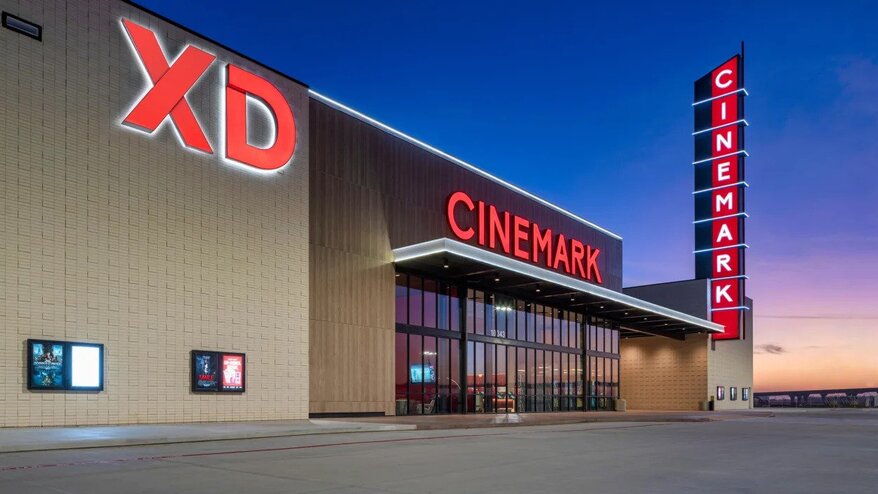Hollywood has framed getting back to theaters as a content problem. But what we need most is to rethink the design of movie theaters altogether.
I can’t remember the last movie I saw in the theater. But I can recall just about everything else about the experience.
There’s the scent of popcorn growing stale under irradiated lamps like the hot line of a truck stop. I remember selecting my exact seat online, upholstered with 20-year-old fabric dank like an intramural hockey player’s equipment bag. I remember the Jenga tower of large concessions balanced atop garbage cans—which I contributed to, carefully, on the way out.
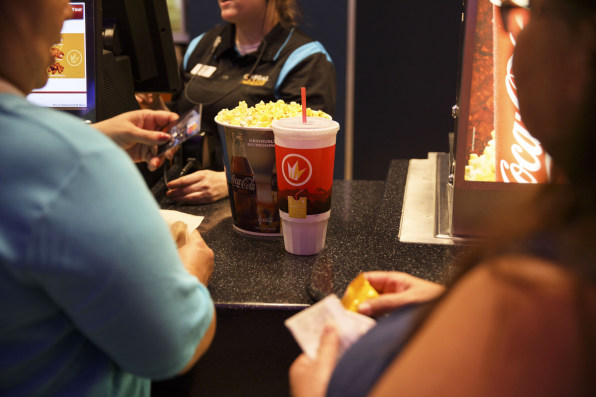
Perhaps these memories were all from one night, or they’re a supercut of many. But they do represent my mental model of my nearest AMC cineplex, which stands as a beige monument to 2000s suburbia—an era when Netflix mailed DVDs and the hottest phone was a Motorola Razr. Even before COVID-19—as plenty of theaters were retrofitted with leather recliners, better image and sound, and dinner offerings—it was clear that the experience of going to the movies was anything but cinematic.
Three years later, the U.S. box office is still down 30% from pre-pandemic levels, and the second largest theater chain in the world, Cineworld (which owns Regal Theaters), has filed for bankruptcy. While the one-two punch of Black Panther and Avatar sequels is sure to boost attendance and end the year on a high(er) note, theaters cannot survive by awaiting the next blockbuster alone, and even members of Hollywood are beginning to acknowledge that. advertisement
“You can’t say we’re doing a Memorial Day movie, a Thanksgiving movie, and a Christmas movie,” says Jon Landau, the producer behind Avatar and Titanic, the first- and third-highest grossing films of all time. “We need to provide [a flow]of content that’s compelling for people to go see [year-round].”
Yet to simply look at movie theaters as a place to see films is a relatively myopic view of the possibilities—a point on which even Landau agrees. The 5,500 indoor movie theaters across the United States are 40,000-square foot buildings, situated in some of the most desirable retail real estate in our country. Yet these theaters operate at 18% to 20% of their capacity on average—a remarkable underutilization of space and creativity.
Movie theaters are not just giant concrete boxes—a Petco with a projector— but powerful social contracts. Where else do people (generally) agree to put away their phones and (generally) sit in silence for a couple hours other than, perhaps, church?
Theaters balance the immersive spectacle of art and technology with the emotional network of a crowd. When we sit in a theater, the art is actually shaped by the location. Why? Research confirms that we take cues from people who sit alongside us, syncing our social response, and very enjoyment of the film, via nonverbal cues so that movies feel more “meh” or “LOL” in concert. Movies, by their very nature, help us agree.
“There are experiences created when you are together with others, and that is still lacking with what [other]technology so far is putting out,” says Wilhelm Oehl, partner at Eight, a creative collective that has designed spaces for both Dolby theaters and Apple retail. “Who knows what the metaverse will do . . . but you feel the energy of a room when you step into it. You feel there is something exciting happening, even if it’s a couple hundred people. It’s difficult to replace that through technology. Humans still want to be with humans.”
In an increasingly digital world where communities have been abstracted into bits, theaters are an in situ anchor to other realities. That’s why, although theaters are bruised, their future could be brighter than ever as the physical home for social multimedia—assuming theaters think beyond the next blockbuster and toward their next experience.

A trailer-length history of how we got here
Today’s movie theater is the product of shifting cultural norms, burgeoning technologies, and, most of all, a century-old business plan that’s never completely made sense.

The first movie theaters were the nickelodeons of the early 1900s. Whereas film had been viewable through peep-show boxes since its advent, requiring people to peer through an eyepiece into machines (not so different from VR headsets!), the Nickelodeon charged 5 cents to come see films projected under an “odeon,” the Greek word for theater with a roof. Entrepreneurs of the era, including Al Ringling from Ringling Circus fame, invested the equivalent of millions of dollars into opening theaters with rich furnishings and live organists, which showed otherwise silent 15-minute films. By 1913, the nickelodeons were gifted a product beyond their wildest dreams. A two-hour Roman epic called Quo Vadis, filmed by Italian director Enrico Guazzoni with 5,000 extras on location, solidified the potential of longer, more ambitious films—and their payoff to investors. New York’s Astor Theater charged $1.50 (about $30 today) to see the movie during its now mind-boggling nine-month run.

Over the ensuing decades, long-running, 90- to 120-minute films became the Hollywood standard—just long enough to optimize many seatings a night and our limbic love for its particular narrative structure.

The resulting slow drip of half-empty movie theaters is partially due to their overbuilt design. It’s widely estimated that Hollywood makes 80% or more of ticket sales in the opening weeks of a film (this number varies by film, studio, and theater), when the majority of people see it. Theater owners don’t get a substantial split on tickets until weeks later, meaning that slow-burn hits on barely filled showings are vital to long-term operations. On average, theaters ultimately walk away with about 55% of the total ticket gross. Still, tickets represent only about 35% to 40% of a theater’s income.
Popcorn (and a newer arm’s race of concessions including everything from alcohol to fried chicken sandwiches) has helped fill the budgetary gap since the Great Depression, when vendors of the dirt-cheap snack were invited—hesitantly!—from the sidewalk outside into the theater itself. Movie theaters make their money by enticing you to eat, and such they are designed.
At the time, this snack marked a huge social shift for the theater-going public. In years prior, attendees were asked to check popcorn with their coats because it was such a noisy comestible. But the rise of talkies (movies with soundtracks rather than card subtitles) solved that issue. With the advent of sound, movies also shifted from leaning toward the rich and literate to become a pastime for everyone.
Ever since, people from all walks of life have experienced the theater as a queue: You buy a ticket, grab concessions, and see a film in a big, dark room. Ignore the carpets and posters, and the human processing of going to a movie is barely different than visiting a Starbucks (but Starbucks offers a seat and Wi-Fi at the end, instead of a feature film).
With movies now a mass-market experience, operators didn’t see the logic in investing in ritzy fits and finishes. Out of WWII into the ‘50s and ‘60s, movie theaters suffered poor attendance, lack of maintenance, and many became pretty sleazy, pushing more explicit, R-rated movies including horror flicks and softcore porn to survive. “TV was blamed for the decline of cinema,” says Karina Aveyard, associate professor of media, arts and humanities at University of Eat Anglia. “But research finds that’s not the only thing at play.” In particular, new families that sprouted out of the war moved from cities to the expanding suburbs that were rich with new shopping centers. These growing families didn’t bring young children to the movies—blame the questionable patrons in trenchcoats, or the rising expenses of suburban consumer goods like lawn mowers—leaving the mostly urban theater landscape to rot.
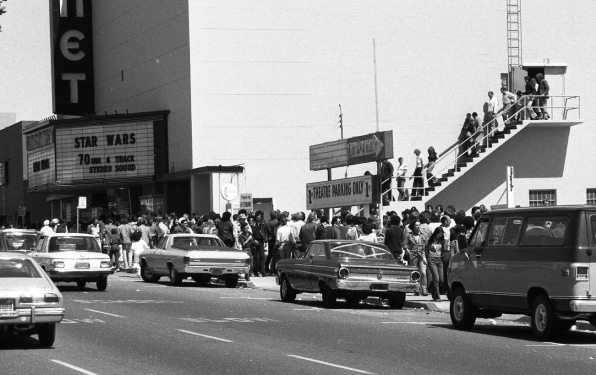
Perhaps theaters would have withered away almost 50 years ago. But the modern spectacle befitting Quo Vadis’s legacy—Jaws (1975) and then Star Wars (1977)—reinvigorated filmmakers and theater operators alike. Investment in theaters started anew: this time, supersized from single screen theaters into multiplexes that began opening in 1979. More screens were followed by creature comforts, and the late ‘80s solved another pain point of cinema: people’s heads. Theaters continued to grow in both size and location with stadium seating.
Over investment and expansion during this time led to widespread theater bankruptcy, and by the late ‘90s, most independently owned theaters closed or were gobbled up by a massive corporate consolidation of the theater industry into the giants AMC, Cinemark, and Regal.

Going full screen
The modern theater experience has marched along a path of technological progress. Into the aughts, theaters invested in higher quality sound and screens, like IMAX, and more comfortable recliner seating. (Even concessions got the 2.0 treatment, when Alamo Drafthouse introduced beer and burgers brought to your seats.)
“We’ve played around with all dimensions on enhancing the experience, except for the peripheral [view],” says theater consultant Doug Darrow, a key figure in the theater industry who helped bring digital projection to theaters when he worked at Texas Instruments on DLP technology and later served as SVP of the Dolby cinema business for more than a decade.
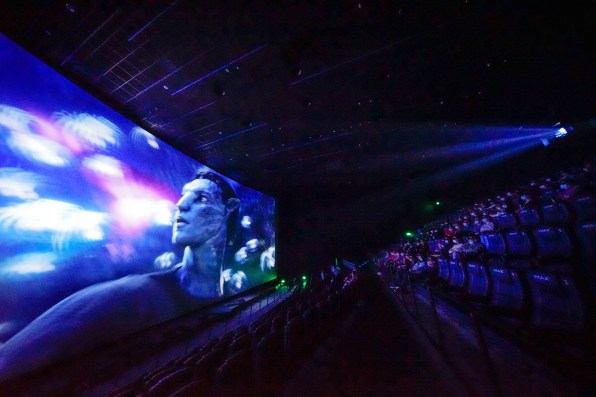
To this day, Darrow is bullish on these tech-first developments in theater design. It’s his business, after all, but he makes a strong argument as to why high-end screens still matter. He points out that Premium Large Format (PLF) screens like IMAX and Dolby have recovered faster in 2022, down only 5% since pre-pandemic levels—and that’s without China or Russia’s market contributing to the gross. Basically, they’re doing fine. The PLF’s higher ticket prices have something to do with that return to form, and surely, these screens entice the most diehard movie fans who were the first to return to theaters anyway.
Where could this arm’s race ultimately lead, unbounded by budget? You can get a hint at the MSG Sphere, which is not a movie theater at all, but a 366-foot-tall live performance venue being built in Las Vegas by Madison Square Garden Entertaiment and the world’s largest architecture firm, Populous. With 580,000 square feet of LEDs covering its 4K video shell and haptic seating for 17,500 people, the Sphere will envelop audiences in live theater and unprecedented spectacle when the first opens next year at The Venetian.
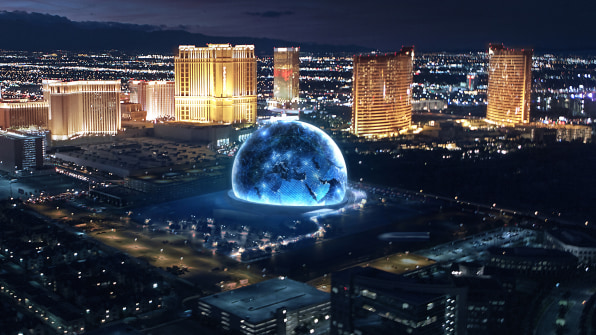
“It’s a little bit like if you ever played the game Civilization, and there’s a bunch of ways to win. With a big army, or building a great wonder of the world. This is [the wonder],” says Jake Barton, founder and principal of Local Projects, which has helped build interactive spaces ranging from the 9/11 Memorial & Museum to a full-body video game room known as the DreamCube. “They’re like, well, throw [$1.6] billion at the problem and maybe it’ll do something . . . that’s arguably not a bad thing, it turns out people really like those experiences.”
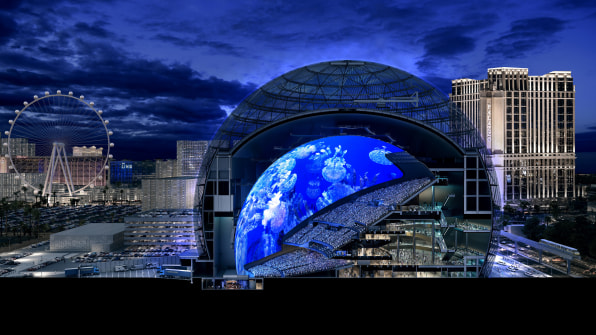
Indeed, the Sphere is the platonic ideal of a PLF theater of the future, and it’s every bit as jaw-dropping as it is unscalable. It’s proof that the future of movie theater design cannot be defined by better projectors or speakers alone, but it seems likely that PLF screens may be the only screens that survive long term.
“The U.S. is the most screened country in the world,” Darrow says. “Can we as an industry still maintain that number of movie theaters? Probably not. So there is some adjustment to the scale that’s been built over the decades.”

Tuning the knobs of the movie theater
How might that adjustment look? Instead of closing cineplexes that might have a dozen or more screens apiece, each cineplex could be cut down to just two or three PLF screens. Then they could reserve all of that extra space for other possibilities.
“As a venue, if the system is unsolved, theaters have a multitude of choices they can explore. If they sit there on a Monday night [complaining]‘I’m slow,’ they have other tools at their beck and call,” says Landau. “It’s not a movie. It’s something different. If you think of a theater as something no different than the Staples Center (one night, it’s baseball, one night it’s hockey, and one night it’s a circus) . . . there’s no reason theaters can’t do that because we’re in this incredible digital age.”
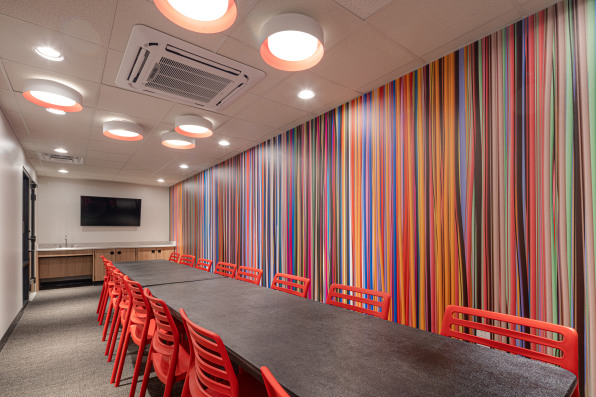
The simplest answer to this problem is to offer more, differentiated content on the screens that stuck around. (Warning: This development can bring us to darkest timeline territory, as AMC recently announced it would host your next corporate Zoom meeting on the big screen.) In any case, live event streaming is still a big opportunity for theaters to ween off movies, and the proof is in the box-office receipts, as a livecast Coldplay concert broke into the top-10 worldwide box office just this month.
These events don’t just pull in customers; they pull in new customers. “Cinema owners I’ve talked to that do livecasting of operas and ballets say the audiences that come to them are not their normal film audience,” says Professor Aveyard. “Those are people not going to films but would come and see the ballet. They dress differently, and behave differently.”
It’s the 1910s all over again.
Concerts, however, are but a tease as to what’s possible if theater owners grow more willing to experiment beyond the bounds of a screen. Even without closing screens, individual theaters themselves could become far more flexible spaces to accommodate more than traditional film projection. Hasier Larrea, founder and CEO of Ori—a startup that creates programmable furniture that can shapeshift on demand—points out that everything from comfortable, retractable seating that can roll in via a remote control to acoustic room dividers that can instantly double or halve a theater’s capacity, exist today. https://www.youtube.com/embed/kJhPuxjAa9A?feature=oembed
In other words, we have the architectural hardware to think more freely about how theater spaces are shaped and utilized. Cineplexes have ample room for accommodating temporary mixed media spaces ranging from local esports tournaments to large-scale interactive exhibits, like the staggering projection environments of TeamLab or new shows like Immersive Van Gogh.
“My working hypothesis is, if you want people to get out of their house, off their couch, off their phone or screen, there needs to be deeper engagement, period,” says Barton. “From a movie theater standpoint, the stuff I’m building and investing in, immersive entertainment is basically saying, let’s optimize experiences in-person for what that affords the audience. It’s social. It’s multisensory. It’s architectural. It’s contextual.”
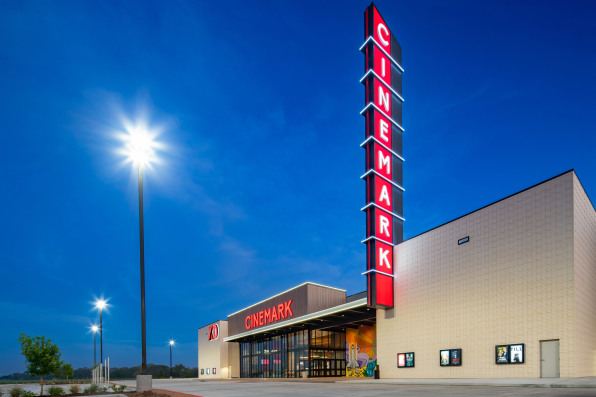
Many of Barton’s themes crop up in the latest rebrand and redesign from Cinemark, the third-largest movie theater chain in the U.S., which launched its new vision on November 10 in a theater in Missouri City, TX. Three years in development, the new theater is designed for immersion, not just onscreen, but in every moment. The project was dubbed Mise-en-scène—a French term “placed on the scene” that captures the entire environmental vibe of a film.

Using qualitative and quantitative testing, Cinemark’s in-house creative team polished each touchpoint of the theater. For people to eat, it reimagined stodgy concessions more like a store—and even the candy selection has been curated with less color repetition so the sweets feel more jubilant and enticing. For people to socialize, it added a lounge area that feels like a coffee shop or hotel lobby off the bar. A high table near concessions offers a place for people to eat, almost like a Chipotle, while TVs adorn the casual seating space with the game on, akin to Buffalo Wild Wings.
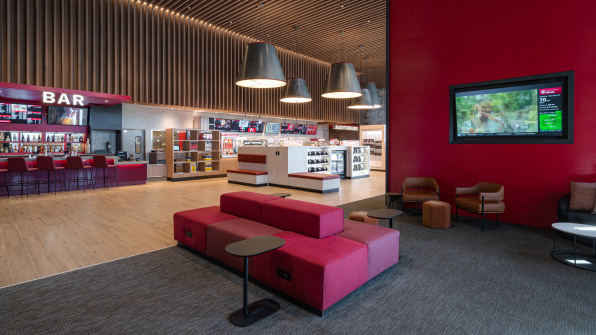
Cinemark modernized their ever-busy cinema carpets with more basic geometries that could also hide stains. Then it updated the dead-feeling hallways between theaters with rich velvet-upholstered seating, and lit them specifically “to create drama,” according to Wanda Gierhart Fearing, Cinemark’s CMO and content officer.
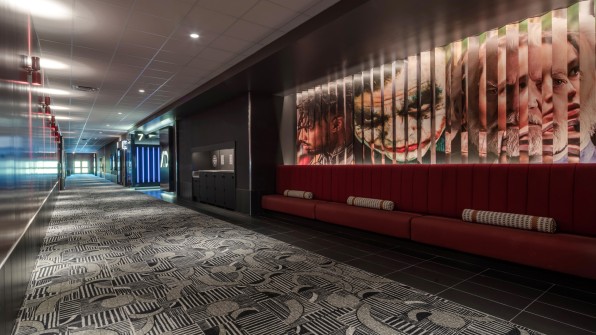
“[Customers] get all hyped when they buy their concession, and then [excitement]kinda drops. And it doesn’t go back up until they’re sitting in their seats and the lights go down,” says Gierhart Fearing. “We don’t want any low moments, from the time you walk in until the movie is on the screen, you should feel excited.”
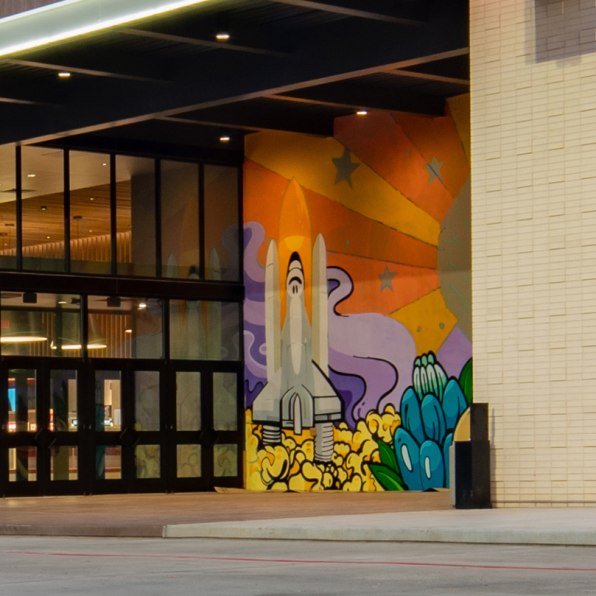
Yet one final touch of the Texas Cinemark may be pulling at the biggest, missed opportunity in movie theaters: It’s a rocketship mural painted by the local artist David Maldonado. This relatively small detail acknowledges where this individual theater lives in the grander scheme of the world.
Movie theaters have barely tapped their own communities
The significance of community in cinema can mean more than laughing with strangers in the dark. Much of Aveyard’s own research has been devoted to the role that theaters play in rural towns, and she’s found that local cinemas, even in relatively small markets, can thrive when acknowledging and embracing their locality.
“If you take a film shot in a country town to that country town, you’ll get 500 people showing up where 15 people would usually,” says Aveyard. “Stretched across the way we use media, so much of what we do online is location-based, and what we post online is so about where we are. There is this powerful sense as humans . . . we are engaged with the way we live. That could be a powerful strategy [for theaters, but]you’re dealing with a big corporate entity that tends to roll out its policies and procedures at a national level. So you have to have a corporate willingness to allow space for local variation.”
Instead of Hollywood beaming a single film to near-identical theaters across the world, Barton of Local Projects suggests that the new model for theaters should be software-driven narrative experiences, which could be customized by audience and location—meaning it’s important that you are experiencing what you are where you are.
What will these experiences actually look like? And how might you consume them alongside other people in a cineplex? Those details aren’t so clear. Barton drops a few hints. He references Silicon Valley’s favorite long-running interactive play Sleep No More, which allows a masked audience to explore a hotel and trail a Shakespearean drama at their leisure. He also references some of his upcoming work on the Audubon Society’s Birdsong project, which will include an installation that uses AI to match you with one of 15,000 bird songs that seems to sing your name, enable you to perform a duet with a bird or take a selfie, and even allow a crowd to follow a bird’s life from egg to a participatory “group flock.” The installations are being planned for yet-to-be-determined spaces in major cities internationally, and will be launched conjunction with nearby city governments and nonprofits—so that many experiences will be available, not simply through cash payment, but by making a commitment to lowering one’s carbon impact at the local level.
“When we imagine this experience, it can and should include big marquee names to drive ticket sales, but if it’s in Brooklyn, it should talk about Brooklyn,” says Barton. “But it’s very different from an experience than a movie.”

